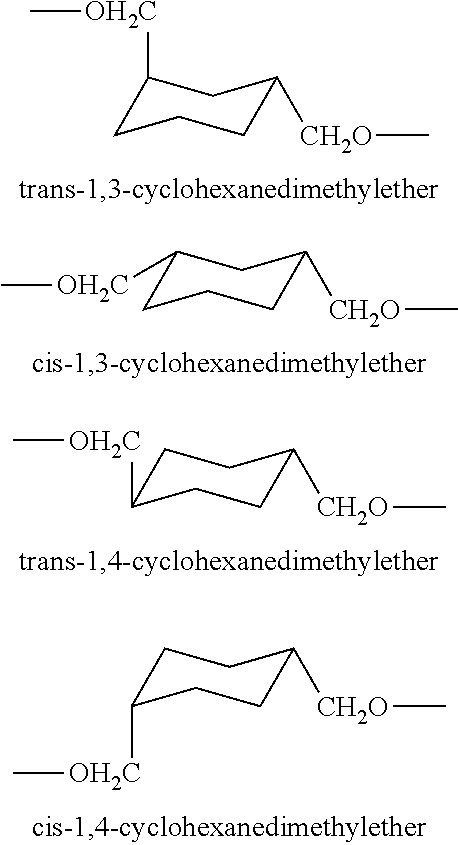Epoxy resins and processes for preparing the same
a technology of epoxy resin and epoxy resin, which is applied in the field of epoxy resin, can solve the problems of difficult storage, transfer, and formulation of epoxy resin, and achieve the effects of increasing the ability of epoxy resin, reducing the difficulty of storage, and reducing the difficulty of forming epoxy resin
- Summary
- Abstract
- Description
- Claims
- Application Information
AI Technical Summary
Benefits of technology
Problems solved by technology
Method used
Image
Examples
example 1
Range Finding CHDM Epoxidation Reactions
[0169]A series of 6 range finding epoxidation reactions (Parts A-F shown in Table I) were completed in 1 L glassware using 0.5 mole (1.0 —OH eq.) CHDM, epi, and solid NaOH (20-40 mesh beads) as reactants. Unless otherwise specified, the mole ratio of isomeric cyclohexanedimethanol:epi:NaOH was 0.5:2:3 (eq ratio of 1:2:3). The CHDM reactant was added as indicated to a stirred slurry of NaOH in epi. Reaction times given in Table I commence with the first addition of the CHDM. Table I summarizes the results from these epoxidation reactions plus salient observations.
TABLE ICHDMExample 1AdditionReactionAnalysis (GC area %)1a(PartsTimeReactionTimeCHDMCHDMA-F)(min)Conditions(hr)CHDMMGEDGEOligomers2DGEA4740° C.3a,3c483b.7.82.8.0.6B6770° C. to 75° C. 1.181.66.74.9one.2over 16 min, 1.44b1.24.10.9.6.6at 71 min 2.04c.32.67.5.7.8cool stepwise 5.04d.130.09.1.9.6to 65° C. andhold4aC21575° C., 5.45a.20.19.9.54.7increased epi 8.25b.095c.07.9.35.8to give a1:3:3...
example 2
Preparation of CHDM MGE and CHDM DGE Free of Oligomeric Components by Vacuum Distillation
[0170]The reaction reported in Part C of Example 1 was terminated via dilution with toluene (200 mL) to facilitate removal of the product slurry from the reactor. The toluene slurry was removed from the reactor and diluted with additional toluene (1.5 L). The slurry was filtered through a pad diatomaceous earth supported on a 600 mL coarse fritted glass funnel. Periodically, salts collecting on top of the pad of diatomaceous earth were scraped off using a spatula to speed the vacuum filtration. The resultant filtrate was rotary evaporated using a maximum bath temperature of 100° C. to provide 145.04 g of light amber colored, transparent liquid. GC analysis revealed the presence of 0.8 area % residual epi, 4.3 area % residual toluene, 0.7 area % unreacted CHDM, 3.7 area % CHDM MGE (1.0, 0.5, 1.5, and 0.7 area % for the 4 individual isomers), 65.1 area % CHDM DGE (15.7, 20.9, 8.4, and 20.1 area % ...
example 3
Preparation of High Purity (>99.5 area %) CHDM DGE (Free of Oligomeric Components) by Vacuum Distillation
[0174]The reaction reported in Part F of Example 1 was terminated via dilution with toluene (200 mL) to facilitate removal from the reactor. The toluene slurry was removed from the reactor and rotary evaporated using a maximum bath temperature of 100° C. to provide a tacky solid product. The product from the rotary evaporation was slurried with acetone (1 L) using vigorous mixing, and then allowed to settle for 1 hr. The cloudy liquid layer which formed on top of the solids which had settled out was decanted through a pad diatomaceous earth supported on a 600 mL coarse fritted glass funnel. Periodically, salts collecting on top of the pad of diatomaceous earth were scraped off using a spatula to speed the vacuum filtration. The filtrate was rotary evaporated to provide 108.9 g of light yellow colored, transparent liquid. The solids, including those removed from the diatomaceous e...
PUM
| Property | Measurement | Unit |
|---|---|---|
| temperature | aaaaa | aaaaa |
| temperature | aaaaa | aaaaa |
| temperature | aaaaa | aaaaa |
Abstract
Description
Claims
Application Information
 Login to View More
Login to View More - R&D
- Intellectual Property
- Life Sciences
- Materials
- Tech Scout
- Unparalleled Data Quality
- Higher Quality Content
- 60% Fewer Hallucinations
Browse by: Latest US Patents, China's latest patents, Technical Efficacy Thesaurus, Application Domain, Technology Topic, Popular Technical Reports.
© 2025 PatSnap. All rights reserved.Legal|Privacy policy|Modern Slavery Act Transparency Statement|Sitemap|About US| Contact US: help@patsnap.com


